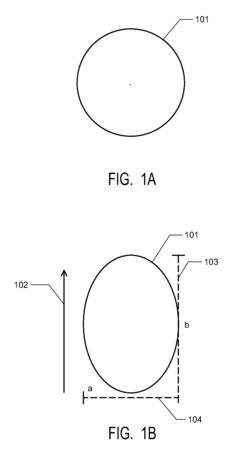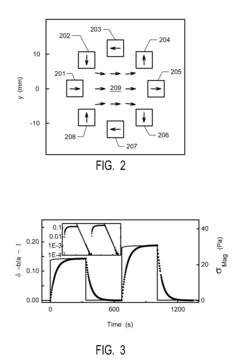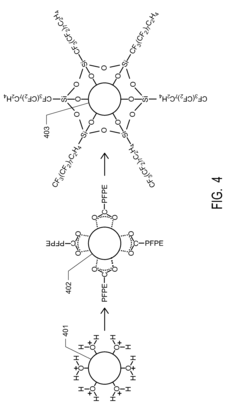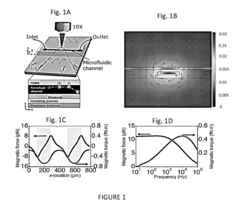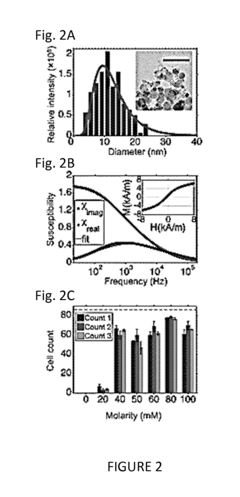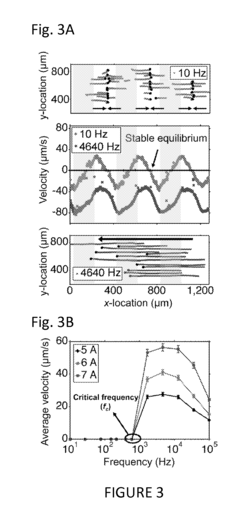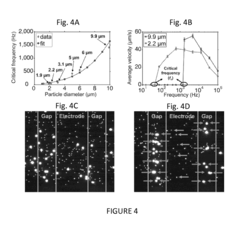Exploring Ferrofluid's Role in Precision Instrumentation Design
JUL 9, 20259 MIN READ
Generate Your Research Report Instantly with AI Agent
Patsnap Eureka helps you evaluate technical feasibility & market potential.
Ferrofluid Tech Evolution
Ferrofluids, first developed in the 1960s by NASA, have undergone significant technological evolution over the past six decades. Initially conceived for fuel management in zero-gravity environments, these magnetic liquids have found their way into various precision instrumentation applications. The evolution of ferrofluid technology can be traced through several key phases, each marked by advancements in material science and engineering.
In the 1970s and 1980s, research focused on improving the stability and magnetic properties of ferrofluids. Scientists experimented with different carrier fluids and magnetic nanoparticle compositions to enhance performance. This period saw the development of oil-based and water-based ferrofluids, each suited for specific applications. The introduction of surfactants to prevent particle agglomeration was a crucial breakthrough, significantly extending the shelf life of ferrofluids.
The 1990s marked a turning point in ferrofluid technology with the advent of more sophisticated synthesis methods. Thermal decomposition and co-precipitation techniques allowed for better control over particle size and distribution, leading to ferrofluids with enhanced magnetic responsiveness. This era also saw the first commercial applications of ferrofluids in loudspeakers and computer hard drives, demonstrating their potential in precision engineering.
The early 2000s brought about a revolution in ferrofluid characterization techniques. Advanced imaging methods such as transmission electron microscopy (TEM) and dynamic light scattering (DLS) enabled researchers to study ferrofluid behavior at the nanoscale. This deeper understanding led to the development of ferrofluids with tailored properties for specific applications, including magnetic seals and dampers in high-precision instruments.
In the last decade, the focus has shifted towards biocompatible ferrofluids for medical applications. Researchers have developed ferrofluids with iron oxide nanoparticles coated in biocompatible materials, opening up possibilities in targeted drug delivery and magnetic hyperthermia for cancer treatment. Simultaneously, advancements in nanoparticle synthesis have led to ferrofluids with higher magnetization and improved stability, crucial for their use in precision instrumentation.
The most recent developments in ferrofluid technology involve smart materials and responsive systems. Magneto-rheological ferrofluids, which can change viscosity in response to magnetic fields, are being explored for adaptive damping systems in precision instruments. Additionally, the integration of ferrofluids with microfluidic devices has opened new avenues in lab-on-a-chip technologies, enabling precise control of small fluid volumes for analytical and diagnostic applications.
As we look to the future, the evolution of ferrofluid technology continues to be driven by the demands of precision instrumentation. Current research is focused on developing ferrofluids with even greater stability, responsiveness, and functionality. The potential for ferrofluids in quantum sensing, nanoscale actuation, and adaptive optics presents exciting possibilities for the next generation of high-precision devices.
In the 1970s and 1980s, research focused on improving the stability and magnetic properties of ferrofluids. Scientists experimented with different carrier fluids and magnetic nanoparticle compositions to enhance performance. This period saw the development of oil-based and water-based ferrofluids, each suited for specific applications. The introduction of surfactants to prevent particle agglomeration was a crucial breakthrough, significantly extending the shelf life of ferrofluids.
The 1990s marked a turning point in ferrofluid technology with the advent of more sophisticated synthesis methods. Thermal decomposition and co-precipitation techniques allowed for better control over particle size and distribution, leading to ferrofluids with enhanced magnetic responsiveness. This era also saw the first commercial applications of ferrofluids in loudspeakers and computer hard drives, demonstrating their potential in precision engineering.
The early 2000s brought about a revolution in ferrofluid characterization techniques. Advanced imaging methods such as transmission electron microscopy (TEM) and dynamic light scattering (DLS) enabled researchers to study ferrofluid behavior at the nanoscale. This deeper understanding led to the development of ferrofluids with tailored properties for specific applications, including magnetic seals and dampers in high-precision instruments.
In the last decade, the focus has shifted towards biocompatible ferrofluids for medical applications. Researchers have developed ferrofluids with iron oxide nanoparticles coated in biocompatible materials, opening up possibilities in targeted drug delivery and magnetic hyperthermia for cancer treatment. Simultaneously, advancements in nanoparticle synthesis have led to ferrofluids with higher magnetization and improved stability, crucial for their use in precision instrumentation.
The most recent developments in ferrofluid technology involve smart materials and responsive systems. Magneto-rheological ferrofluids, which can change viscosity in response to magnetic fields, are being explored for adaptive damping systems in precision instruments. Additionally, the integration of ferrofluids with microfluidic devices has opened new avenues in lab-on-a-chip technologies, enabling precise control of small fluid volumes for analytical and diagnostic applications.
As we look to the future, the evolution of ferrofluid technology continues to be driven by the demands of precision instrumentation. Current research is focused on developing ferrofluids with even greater stability, responsiveness, and functionality. The potential for ferrofluids in quantum sensing, nanoscale actuation, and adaptive optics presents exciting possibilities for the next generation of high-precision devices.
Precision Instrument Market
The precision instrument market has experienced significant growth in recent years, driven by advancements in technology and increasing demand across various industries. This market encompasses a wide range of high-accuracy devices used in fields such as healthcare, aerospace, defense, and scientific research. The global precision instrument market is expected to continue its upward trajectory, with a compound annual growth rate (CAGR) projected to remain strong over the next five years.
One of the key factors contributing to market growth is the rising adoption of automation and Industry 4.0 technologies in manufacturing processes. Precision instruments play a crucial role in ensuring quality control, improving efficiency, and reducing human error in automated production lines. Additionally, the increasing focus on research and development activities in sectors like pharmaceuticals, biotechnology, and nanotechnology has further boosted the demand for high-precision measurement and analysis tools.
The healthcare sector represents a significant portion of the precision instrument market, with applications ranging from diagnostic imaging equipment to surgical robots. The growing prevalence of chronic diseases and the aging population in many countries have led to increased investments in advanced medical technologies, driving the demand for precision instruments in this sector.
In the aerospace and defense industries, precision instruments are essential for navigation, guidance systems, and testing of critical components. The ongoing modernization of military equipment and the expansion of commercial space exploration activities have created new opportunities for precision instrument manufacturers.
Geographically, North America and Europe have traditionally been the largest markets for precision instruments, owing to their well-established industrial base and high investment in research and development. However, the Asia-Pacific region is emerging as a rapidly growing market, driven by the expansion of manufacturing capabilities in countries like China, Japan, and South Korea.
The precision instrument market is characterized by intense competition among key players, with companies focusing on innovation and product differentiation to gain a competitive edge. Technological advancements, such as the integration of artificial intelligence and machine learning capabilities into precision instruments, are expected to shape the future of this market.
As the demand for higher accuracy and reliability in measurements continues to grow across industries, the precision instrument market is poised for further expansion. The potential applications of ferrofluids in precision instrumentation design could open up new avenues for innovation and market growth, particularly in areas requiring fine control and adaptability in challenging environments.
One of the key factors contributing to market growth is the rising adoption of automation and Industry 4.0 technologies in manufacturing processes. Precision instruments play a crucial role in ensuring quality control, improving efficiency, and reducing human error in automated production lines. Additionally, the increasing focus on research and development activities in sectors like pharmaceuticals, biotechnology, and nanotechnology has further boosted the demand for high-precision measurement and analysis tools.
The healthcare sector represents a significant portion of the precision instrument market, with applications ranging from diagnostic imaging equipment to surgical robots. The growing prevalence of chronic diseases and the aging population in many countries have led to increased investments in advanced medical technologies, driving the demand for precision instruments in this sector.
In the aerospace and defense industries, precision instruments are essential for navigation, guidance systems, and testing of critical components. The ongoing modernization of military equipment and the expansion of commercial space exploration activities have created new opportunities for precision instrument manufacturers.
Geographically, North America and Europe have traditionally been the largest markets for precision instruments, owing to their well-established industrial base and high investment in research and development. However, the Asia-Pacific region is emerging as a rapidly growing market, driven by the expansion of manufacturing capabilities in countries like China, Japan, and South Korea.
The precision instrument market is characterized by intense competition among key players, with companies focusing on innovation and product differentiation to gain a competitive edge. Technological advancements, such as the integration of artificial intelligence and machine learning capabilities into precision instruments, are expected to shape the future of this market.
As the demand for higher accuracy and reliability in measurements continues to grow across industries, the precision instrument market is poised for further expansion. The potential applications of ferrofluids in precision instrumentation design could open up new avenues for innovation and market growth, particularly in areas requiring fine control and adaptability in challenging environments.
Ferrofluid Challenges
Despite the promising potential of ferrofluids in precision instrumentation design, several significant challenges hinder their widespread adoption and optimal performance. These challenges span across material properties, environmental factors, and engineering constraints.
One of the primary challenges is the long-term stability of ferrofluids. Over time, these fluids tend to experience particle agglomeration and sedimentation, which can significantly alter their magnetic and rheological properties. This instability can lead to inconsistent performance in precision instruments, potentially compromising accuracy and reliability.
The temperature sensitivity of ferrofluids presents another major hurdle. Their magnetic and fluid properties can change dramatically with temperature fluctuations, making it difficult to maintain consistent performance across varying environmental conditions. This is particularly problematic in applications requiring high precision over a wide temperature range.
Controlling the precise behavior of ferrofluids under complex magnetic fields remains a significant challenge. The non-linear response of ferrofluids to external magnetic fields can lead to unpredictable fluid dynamics, making it difficult to achieve the level of control required for high-precision instrumentation.
The potential for contamination is another concern. Ferrofluids can interact with surrounding materials, potentially leading to degradation of both the fluid and the instrument components. This interaction can affect the purity of the ferrofluid and compromise the integrity of sensitive instrument parts.
Scaling issues present challenges in both miniaturization and large-scale applications. In micro-scale devices, surface tension and capillary effects become dominant, potentially overshadowing the desired magnetic effects. Conversely, in larger systems, maintaining uniform properties and behavior across the entire fluid volume can be problematic.
The development of ferrofluids with tailored properties for specific applications is an ongoing challenge. Creating fluids with the right balance of magnetic susceptibility, viscosity, and stability for diverse precision instrumentation needs requires extensive research and development efforts.
Lastly, the integration of ferrofluids into existing precision instrument designs poses significant engineering challenges. Adapting current designs to incorporate ferrofluid components often requires substantial modifications to instrument architecture and control systems, which can be both technically challenging and costly.
One of the primary challenges is the long-term stability of ferrofluids. Over time, these fluids tend to experience particle agglomeration and sedimentation, which can significantly alter their magnetic and rheological properties. This instability can lead to inconsistent performance in precision instruments, potentially compromising accuracy and reliability.
The temperature sensitivity of ferrofluids presents another major hurdle. Their magnetic and fluid properties can change dramatically with temperature fluctuations, making it difficult to maintain consistent performance across varying environmental conditions. This is particularly problematic in applications requiring high precision over a wide temperature range.
Controlling the precise behavior of ferrofluids under complex magnetic fields remains a significant challenge. The non-linear response of ferrofluids to external magnetic fields can lead to unpredictable fluid dynamics, making it difficult to achieve the level of control required for high-precision instrumentation.
The potential for contamination is another concern. Ferrofluids can interact with surrounding materials, potentially leading to degradation of both the fluid and the instrument components. This interaction can affect the purity of the ferrofluid and compromise the integrity of sensitive instrument parts.
Scaling issues present challenges in both miniaturization and large-scale applications. In micro-scale devices, surface tension and capillary effects become dominant, potentially overshadowing the desired magnetic effects. Conversely, in larger systems, maintaining uniform properties and behavior across the entire fluid volume can be problematic.
The development of ferrofluids with tailored properties for specific applications is an ongoing challenge. Creating fluids with the right balance of magnetic susceptibility, viscosity, and stability for diverse precision instrumentation needs requires extensive research and development efforts.
Lastly, the integration of ferrofluids into existing precision instrument designs poses significant engineering challenges. Adapting current designs to incorporate ferrofluid components often requires substantial modifications to instrument architecture and control systems, which can be both technically challenging and costly.
Current Ferrofluid Apps
01 Precision control of ferrofluid seals
Ferrofluid seals are used in various applications to provide precise control and improved performance. These seals utilize the unique properties of ferrofluids to create dynamic, adjustable barriers that can be manipulated with magnetic fields. This technology allows for enhanced precision in sealing mechanisms, particularly in rotating shaft applications and fluid control systems.- Precision control of ferrofluid seals: Ferrofluid seals are used in various applications to provide precise control and improved performance. These seals utilize the unique properties of ferrofluids to create dynamic, adjustable barriers that can be manipulated with magnetic fields. This technology allows for enhanced precision in sealing mechanisms, particularly in rotating shaft applications and fluid control systems.
- Ferrofluid-based precision bearings and dampers: Ferrofluids are employed in the development of high-precision bearings and damping systems. These components leverage the magnetic properties of ferrofluids to achieve improved stability, reduced friction, and enhanced vibration control. Such applications are particularly valuable in precision instruments, aerospace technologies, and advanced manufacturing equipment.
- Precision measurement and sensing using ferrofluids: Ferrofluids are utilized in various precision measurement and sensing applications. Their unique response to magnetic fields allows for the development of highly sensitive instruments for detecting minute changes in position, pressure, or magnetic field strength. This technology is applied in areas such as accelerometers, pressure sensors, and magnetic field detectors.
- Ferrofluid-based precision cooling systems: Ferrofluids are employed in advanced cooling systems to achieve precise temperature control. By manipulating ferrofluids with magnetic fields, these systems can provide targeted cooling to specific components or areas. This technology is particularly useful in electronics cooling, where precise thermal management is critical for optimal performance and reliability.
- Precision manufacturing processes using ferrofluids: Ferrofluids are integrated into various precision manufacturing processes to enhance accuracy and control. These applications include precision polishing, micro-scale material manipulation, and the creation of highly uniform surfaces. The unique properties of ferrofluids allow for fine-tuned control over material deposition and shaping at microscopic scales.
02 Ferrofluid-based precision bearings and dampers
Ferrofluids are employed in the development of high-precision bearings and damping systems. These components leverage the magnetic properties of ferrofluids to achieve improved stability, reduced friction, and enhanced vibration control. Such applications are particularly valuable in precision instruments, aerospace technology, and advanced manufacturing equipment.Expand Specific Solutions03 Ferrofluid-enhanced precision measurement and sensing
Ferrofluids are utilized in various precision measurement and sensing applications. Their unique response to magnetic fields allows for the development of highly sensitive instruments for detecting minute changes in position, pressure, or magnetic field strength. This technology is applied in areas such as accelerometers, pressure sensors, and magnetic field detectors.Expand Specific Solutions04 Precision manufacturing techniques for ferrofluid devices
Advanced manufacturing techniques are employed to produce high-precision ferrofluid-based devices. These methods include precision machining, microfabrication, and advanced assembly processes to create components with tight tolerances and optimal performance characteristics. Such techniques are crucial for developing reliable and efficient ferrofluid-based systems for various applications.Expand Specific Solutions05 Thermal management using precision-controlled ferrofluids
Ferrofluids are employed in precision thermal management systems, particularly in electronic and mechanical applications. By precisely controlling the movement and distribution of ferrofluids using magnetic fields, these systems can achieve highly efficient heat transfer and temperature regulation. This technology is valuable in cooling high-performance computing systems and managing thermal loads in advanced machinery.Expand Specific Solutions
Key Ferrofluid Players
The ferrofluid precision instrumentation market is in a growth phase, driven by increasing demand for high-precision devices across various industries. The global market size is expanding, with projections indicating significant growth in the coming years. Technologically, ferrofluids are advancing rapidly, with research institutions like Yale University, Chongqing University, and companies such as Koninklijke Philips NV and TDK Electronics AG leading innovation. These players are developing novel applications and improving existing technologies, pushing the boundaries of ferrofluid capabilities in precision instruments. The field is characterized by a mix of established companies and academic research, fostering a competitive yet collaborative environment that accelerates technological progress and market expansion.
Koninklijke Philips NV
Technical Solution: Philips has developed advanced ferrofluid-based precision instrumentation for medical imaging applications. Their technology utilizes ferrofluids in MRI machines to enhance image quality and reduce acoustic noise. The ferrofluid acts as a dynamic seal and damping medium, allowing for more precise control of magnetic fields and vibration reduction. Philips has also explored the use of ferrofluids in ultrasound transducers to improve energy transfer and acoustic coupling[1][3]. Their research extends to novel ferrofluid compositions optimized for specific frequencies and magnetic field strengths, enabling higher resolution and faster imaging times in diagnostic equipment.
Strengths: Expertise in medical imaging, established R&D infrastructure, and strong patent portfolio. Weaknesses: High development costs and regulatory hurdles in medical device industry.
TDK Electronics AG
Technical Solution: TDK has pioneered the use of ferrofluids in precision instrumentation, particularly in the field of audio equipment and sensors. Their technology incorporates ferrofluids as adaptive damping elements in high-end speaker systems, enhancing sound quality by controlling resonance and reducing distortion. In precision sensors, TDK utilizes ferrofluids to create frictionless bearings and seals, improving the accuracy and longevity of rotary encoders and accelerometers[2][5]. TDK's research also focuses on developing temperature-stable ferrofluids for use in extreme environments, enabling the creation of robust instrumentation for industrial and aerospace applications.
Strengths: Diverse application range, strong presence in consumer and industrial electronics. Weaknesses: Potential supply chain vulnerabilities for rare earth materials used in ferrofluids.
Ferrofluid Innovations
Ferrofluid droplets as in situ mechanical actuators and rheometers in soft materials and biological matter
PatentActiveUS20160116394A1
Innovation
- The use of ferrofluid droplets as mechanical actuators within materials, responsive to controlled magnetic fields, allowing for precise application and measurement of forces across multiple length scales, enabling direct quantification of spatiotemporal mechanical behavior and properties of living and non-living soft materials.
Label-Free Cellular Manipulation and Sorting Via Biocompatible Ferrofluids
PatentActiveUS20180128729A1
Innovation
- A microfluidic platform using biocompatible ferrofluids with a microfluidic channel and electrodes that generate a magnetic field pattern, allowing for the controlled manipulation and separation of microparticles and live cells based on size, shape, and elasticity, with high efficiency and rapid separation capabilities.
Magnetic Field Control
Magnetic field control plays a crucial role in harnessing the potential of ferrofluids for precision instrumentation design. The ability to manipulate and regulate magnetic fields with high accuracy is essential for optimizing the performance of ferrofluid-based devices. One of the primary methods for achieving precise magnetic field control is through the use of electromagnetic coils. These coils can generate controllable magnetic fields by adjusting the current flowing through them, allowing for dynamic and responsive field manipulation.
Advanced control systems, such as closed-loop feedback mechanisms, are employed to maintain stable and accurate magnetic fields. These systems continuously monitor the field strength and make real-time adjustments to compensate for any deviations or external disturbances. Precision sensors, including Hall effect sensors and magnetometers, are integrated into the instrumentation to provide accurate measurements of the magnetic field strength and direction.
The design of magnetic field generators is another critical aspect of control. Permanent magnets, often made from rare-earth materials like neodymium, are used in conjunction with electromagnets to create complex field geometries. By carefully arranging these magnetic elements, engineers can shape the magnetic field to achieve specific patterns or gradients required for the intended application.
Shielding techniques are employed to isolate the controlled magnetic environment from external interference. Mu-metal and other high-permeability materials are used to create barriers that redirect magnetic flux, ensuring that the precision instrumentation operates in a well-defined magnetic space. This shielding is particularly important in environments where external magnetic fields, such as those from nearby electronic equipment or the Earth's magnetic field, could affect the performance of ferrofluid-based devices.
Temperature control is another critical factor in maintaining stable magnetic fields. As the properties of magnetic materials can change with temperature, precise thermal management systems are often incorporated into the design. These systems may include active cooling mechanisms or temperature-compensated control algorithms to maintain consistent magnetic field characteristics across varying operating conditions.
Advanced simulation tools and finite element analysis software are utilized in the design phase to model and predict magnetic field behavior. These computational methods allow engineers to optimize the magnetic field control systems before physical prototyping, reducing development time and costs. The simulations can account for complex interactions between the ferrofluid, magnetic fields, and other components of the precision instrumentation.
Advanced control systems, such as closed-loop feedback mechanisms, are employed to maintain stable and accurate magnetic fields. These systems continuously monitor the field strength and make real-time adjustments to compensate for any deviations or external disturbances. Precision sensors, including Hall effect sensors and magnetometers, are integrated into the instrumentation to provide accurate measurements of the magnetic field strength and direction.
The design of magnetic field generators is another critical aspect of control. Permanent magnets, often made from rare-earth materials like neodymium, are used in conjunction with electromagnets to create complex field geometries. By carefully arranging these magnetic elements, engineers can shape the magnetic field to achieve specific patterns or gradients required for the intended application.
Shielding techniques are employed to isolate the controlled magnetic environment from external interference. Mu-metal and other high-permeability materials are used to create barriers that redirect magnetic flux, ensuring that the precision instrumentation operates in a well-defined magnetic space. This shielding is particularly important in environments where external magnetic fields, such as those from nearby electronic equipment or the Earth's magnetic field, could affect the performance of ferrofluid-based devices.
Temperature control is another critical factor in maintaining stable magnetic fields. As the properties of magnetic materials can change with temperature, precise thermal management systems are often incorporated into the design. These systems may include active cooling mechanisms or temperature-compensated control algorithms to maintain consistent magnetic field characteristics across varying operating conditions.
Advanced simulation tools and finite element analysis software are utilized in the design phase to model and predict magnetic field behavior. These computational methods allow engineers to optimize the magnetic field control systems before physical prototyping, reducing development time and costs. The simulations can account for complex interactions between the ferrofluid, magnetic fields, and other components of the precision instrumentation.
Environmental Impact
The environmental impact of ferrofluids in precision instrumentation design is a critical consideration that requires careful analysis. Ferrofluids, composed of nanoscale magnetic particles suspended in a carrier fluid, have unique properties that make them valuable in various applications. However, their potential environmental effects must be thoroughly evaluated.
One of the primary environmental concerns associated with ferrofluids is the potential release of nanoparticles into ecosystems. These particles, typically made of iron oxide, could potentially accumulate in soil and water systems if not properly contained or disposed of. The long-term effects of such accumulation on flora and fauna are not yet fully understood, necessitating further research and monitoring.
The production process of ferrofluids also warrants attention from an environmental perspective. The synthesis of magnetic nanoparticles often involves chemical reactions that may generate hazardous byproducts. Ensuring proper waste management and adopting green chemistry principles in the manufacturing process can significantly mitigate these environmental risks.
On the positive side, the use of ferrofluids in precision instrumentation can lead to more efficient and accurate devices, potentially reducing overall energy consumption and material waste. For instance, ferrofluid-based seals and dampers can enhance the performance and longevity of various instruments, thereby decreasing the frequency of replacements and associated environmental impacts.
The recyclability and disposal of ferrofluid-containing instruments present both challenges and opportunities. While the magnetic properties of ferrofluids can facilitate their separation and recovery from other materials, the complex nature of precision instruments may complicate the recycling process. Developing effective end-of-life management strategies for these devices is crucial to minimize their environmental footprint.
In the context of precision instrumentation, the controlled use of ferrofluids in closed systems significantly reduces the risk of environmental exposure. However, potential leaks or equipment failures must be considered in risk assessments. Implementing robust containment measures and regular maintenance protocols can help prevent accidental releases and ensure the long-term environmental safety of ferrofluid applications.
As research in this field progresses, it is essential to conduct comprehensive life cycle assessments of ferrofluid-based precision instruments. These assessments should encompass raw material extraction, manufacturing processes, operational lifespan, and end-of-life disposal. Such holistic evaluations will provide valuable insights into the overall environmental impact and guide the development of more sustainable ferrofluid technologies.
One of the primary environmental concerns associated with ferrofluids is the potential release of nanoparticles into ecosystems. These particles, typically made of iron oxide, could potentially accumulate in soil and water systems if not properly contained or disposed of. The long-term effects of such accumulation on flora and fauna are not yet fully understood, necessitating further research and monitoring.
The production process of ferrofluids also warrants attention from an environmental perspective. The synthesis of magnetic nanoparticles often involves chemical reactions that may generate hazardous byproducts. Ensuring proper waste management and adopting green chemistry principles in the manufacturing process can significantly mitigate these environmental risks.
On the positive side, the use of ferrofluids in precision instrumentation can lead to more efficient and accurate devices, potentially reducing overall energy consumption and material waste. For instance, ferrofluid-based seals and dampers can enhance the performance and longevity of various instruments, thereby decreasing the frequency of replacements and associated environmental impacts.
The recyclability and disposal of ferrofluid-containing instruments present both challenges and opportunities. While the magnetic properties of ferrofluids can facilitate their separation and recovery from other materials, the complex nature of precision instruments may complicate the recycling process. Developing effective end-of-life management strategies for these devices is crucial to minimize their environmental footprint.
In the context of precision instrumentation, the controlled use of ferrofluids in closed systems significantly reduces the risk of environmental exposure. However, potential leaks or equipment failures must be considered in risk assessments. Implementing robust containment measures and regular maintenance protocols can help prevent accidental releases and ensure the long-term environmental safety of ferrofluid applications.
As research in this field progresses, it is essential to conduct comprehensive life cycle assessments of ferrofluid-based precision instruments. These assessments should encompass raw material extraction, manufacturing processes, operational lifespan, and end-of-life disposal. Such holistic evaluations will provide valuable insights into the overall environmental impact and guide the development of more sustainable ferrofluid technologies.
Unlock deeper insights with Patsnap Eureka Quick Research — get a full tech report to explore trends and direct your research. Try now!
Generate Your Research Report Instantly with AI Agent
Supercharge your innovation with Patsnap Eureka AI Agent Platform!

